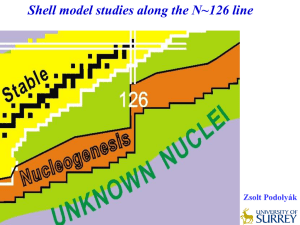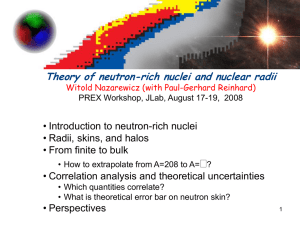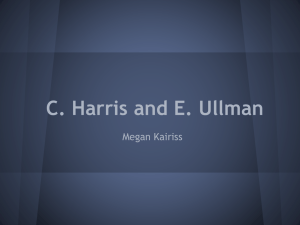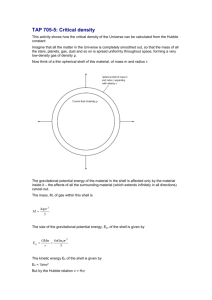90Rh_final
advertisement
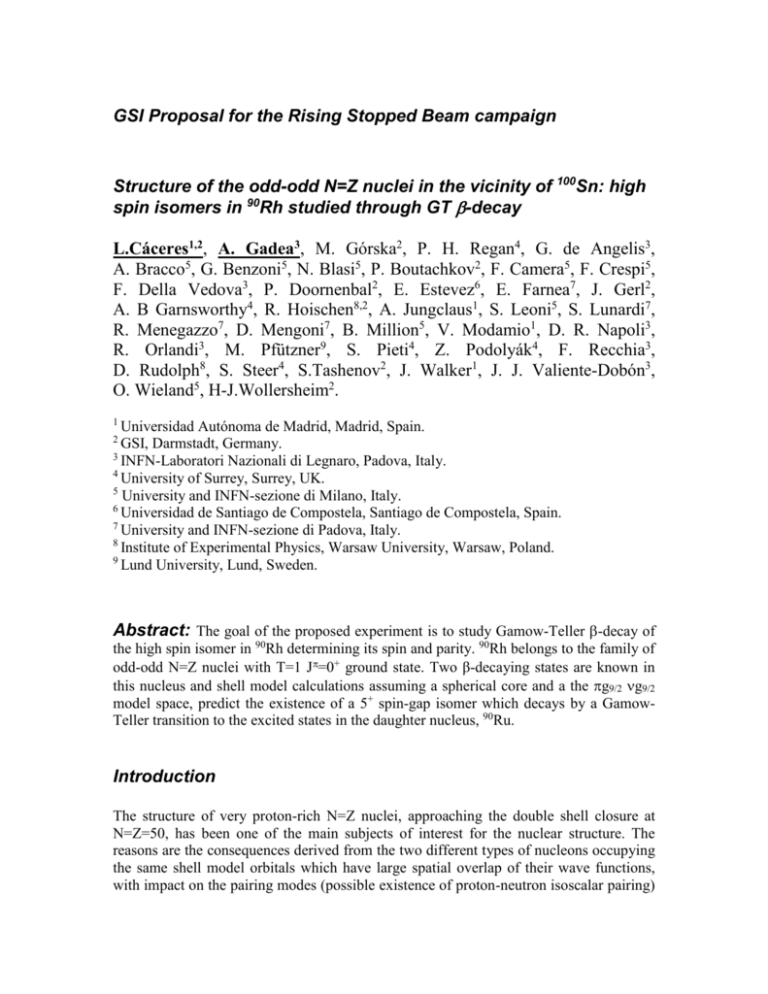
GSI Proposal for the Rising Stopped Beam campaign Structure of the odd-odd N=Z nuclei in the vicinity of 100Sn: high spin isomers in 90Rh studied through GT -decay L.Cáceres1,2, A. Gadea3, M. Górska2, P. H. Regan4, G. de Angelis3, A. Bracco5, G. Benzoni5, N. Blasi5, P. Boutachkov2, F. Camera5, F. Crespi5, F. Della Vedova3, P. Doornenbal2, E. Estevez6, E. Farnea7, J. Gerl2, A. B Garnsworthy4, R. Hoischen8,2, A. Jungclaus1, S. Leoni5, S. Lunardi7, R. Menegazzo7, D. Mengoni7, B. Million5, V. Modamio1, D. R. Napoli3, R. Orlandi3, M. Pfützner9, S. Pieti4, Z. Podolyák4, F. Recchia3, D. Rudolph8, S. Steer4, S.Tashenov2, J. Walker1, J. J. Valiente-Dobón3, O. Wieland5, H-J.Wollersheim2. 1 Universidad Autónoma de Madrid, Madrid, Spain. GSI, Darmstadt, Germany. 3 INFN-Laboratori Nazionali di Legnaro, Padova, Italy. 4 University of Surrey, Surrey, UK. 5 University and INFN-sezione di Milano, Italy. 6 Universidad de Santiago de Compostela, Santiago de Compostela, Spain. 7 University and INFN-sezione di Padova, Italy. 8 Institute of Experimental Physics, Warsaw University, Warsaw, Poland. 9 Lund University, Lund, Sweden. 2 Abstract: The goal of the proposed experiment is to study Gamow-Teller -decay of the high spin isomer in 90Rh determining its spin and parity. 90Rh belongs to the family of odd-odd N=Z nuclei with T=1 J=0+ ground state. Two β-decaying states are known in this nucleus and shell model calculations assuming a spherical core and a the g9/2 g9/2 model space, predict the existence of a 5+ spin-gap isomer which decays by a GamowTeller transition to the excited states in the daughter nucleus, 90Ru. Introduction The structure of very proton-rich N=Z nuclei, approaching the double shell closure at N=Z=50, has been one of the main subjects of interest for the nuclear structure. The reasons are the consequences derived from the two different types of nucleons occupying the same shell model orbitals which have large spatial overlap of their wave functions, with impact on the pairing modes (possible existence of proton-neutron isoscalar pairing) as well as the behavior of the nuclear system in which protons and neutrons contribute coherently to build, especially, the collective phenomena. Odd-odd heavy N=Z nuclei present aspects that characterize them as important targets for the structure studies. In nuclei heavier than mass A=40, with the exception of 58Cu [1], contrary to what has been observed in lighter ones, the T=1, J=0+ state becomes the ground state. The evolution of collectivity in the pfg shell indicates a maximum of deformation around 78 Y. Due to limitation in the model space, shell model calculations fail to reproduce the recent experimental data. In fact isomers observed in 82Nb, 86Tc [2] are better described in the framework of deformation. Moreover maximum aligned T=0 J=9+ (proton-neutron pairing) isomeric state predicted by the shell model calculation to decay by GamowTeller beta-decay was not observed [3] in these nuclei. However, going towards the doubly magic 100Sn the deformation seems to vanish and in fact shell model calculations reproduce successfully the level scheme of 94Pd and 94Ag [4]. The most relevant predictions indicate the presence of high spin-gap isomers caused by the T=0 coupling of maximum aligned nucleons. In the odd-odd N=Z nuclei from 90Rh up to 98In isomers decaying by Gamow-Teller transitions are predicted together with the superallowed ground state Fermi decay. Indeed, Kienle et al. [3] observed the presence of long and short beta decay lifetimes in 90Rh, 94Ag and 98In nuclei. The same work points out a discrepancy between the lifetimes of the Gamow-Teller transition and the predicted ones [5]. Therefore, the measurement of the spin and parity of beta decaying isomers and their excitation energy will provide crucial information concerning the structure of these nuclei. The goal of this proposal is to measure the Gamow-Teller strength of the 90Rh isomeric state and determine its spin and parity. The spin and parity of this isomer is predicted by shell model calculation with Gross-Frenkel empirical matrix elements [6] to be 5+ at 1.1MeV excitation energy. On the other hand Hernld and Brown [7] predict a low lying 4- state at the same excitation energy. In addition to the interest of these studies in terms of the nuclear structure, the unitarity of the Cabibbo-Kobayashi-Maskawa matrix by comparition of superallowed Fermi decay in these nuclei to the muon decay lifetime can be tested. This requires a deep understanding of the nuclear wavefunction to correct the measured ft values. The nuclear structure corrections to these measured ft values come from isospin mixing effect as well as from the radial overlap between the proton and neutron wavefuntions. A good knowledge of the nuclear structure, in this region where rapid change of collectivity occurs, is of paramount importance for the calculation of these corrections. The 90Rh physics case: Moving on the N=Z line from the middle of the pfg shell (78Y) towards 100Sn, 90Rh is the first odd-odd nucleus with a beta-decaying isomeric state. Within the shell model approach long lived beta decaying isomers are predicted in all odd-odd N=Z g9/2 nuclei from 82Nb to 98In. In Fig. 2 the predictions of those isomers based on the Gross-Frenkel interaction are shown for the whole chain. Figure 1: The pfg shell N=Z odd-odd nuclei with T=1 ground state. The lifetime of the Fermi decaying ground state and of the known isomers is indicated. Figure 2: Predicted isomers with the Gross-Frenkel interaction for the odd-odd N=Z nuclei in the pfg shell. The 0+, T=1 90Rh ground state was measured to decay by a superallowed Fermi transition [3] to the ground state of the daughter nucleus, 90Ru [8]. Another long-lived high-spin isomeric state (T1/2 = 1.0 s) belonging to 90Rh was reported as well by Kienle et al. in Ref. [3]. The spin and parity assignment of the long-lived isomeric state in 90Rh will be extracted by the balance of the gamma-decay intensity to the levels in 90Ru (Fig 3). If the isomer is a 5+ as predicted, the unpaired g9/2 proton will decay to a g9/2 neutron and the gamma transitions associated with the deexcitation of the 4+ and 6+ excited states in 90Ru will be observed. Therefore an increase in gamma intensity corresponding to the deexcitation of the 4+ state will be visible. The effect can be easily study by analyzing the beta-delayed gamma coincidence spectrum. The experimentally known negative parity cascade in 90Ru is interpreted to be formed by coupling one g9/2 proton and one f5/2 proton [8]. If the observed isomeric state in 90Rh is the 4- as predicted by Hernd and Brown [7], with p1/2 proton and g9/2 neutron assigned configuration, then the the 5- excited state in 90Ru will not be populated. Instead new negative parity states involving the neutron p1/2 g9/2 configuration will be directly fed. However, the gamma spectrum of 90Ru populated in the beta-decay of 90Rh is completely unknown; therefore we expect to populate low-lying non-yrast states of the daughter nucleus as well as the yrast states, which will provide additional information about other contributions to the 90Rh ground state wavefunction. Figure 3: Level scheme of 90Ru obtained in fusion-evaporation measurement. Experimental Method: We propose to study the Gamow-Teller beta-decay of the 90Rh high spin isomer by fragmentation of 750MeV/u 107Ag on a 4011mg/cm2 9Be target. The reactions products will be separated and identified unambiguously by means of Bρ – ΔE - Bρ method in the Fragment Separator (FRS) at GSI. The identified fragments will be implanted into a double-sided strip detector system (DSSDs), with area of 5 x 5 cm2 with 16 x 16 strips, placed in the S4 focal plane of the FRS. The stopper will be placed in the target position and viewed by the standard RISING Ge detector array in close geometry (55o, 90o, 1250) which will allows to measure beta-delayed gammas-rays. Time correlation between the ion implanted and emitted beta particle will permit to extract the beta-decay half-life with high accuracy. The beta branching ratio will be extracted from the gamma transition intensities in daughter nucleus. The implantation rate at the last focal plane is given by: I sec 1 cm 2 d g / cm 2 A1 mol / g sec 1 Ttot N A mol 1 With σ : cross section ~1.043 nb d : target thickness ~4.011 g/cm2 A : atomic mass of the target = 9 : primary beam current ~1 x 10 9 ions per second. Ttot : total transmition to the stopper ~40 % NA : Avogadro constant We expect to produce ~6.7 iones of 90Rh per minute or approximately 9670 ions per day. If we assume an isomeric ratio of 10 % and a beta efficiency of 100 %, then the number of beta decays per day will be: Rday 1 I day 1 Riso 967decays / day Since the Q-value is more than 13 MeV [9], more than 99.5% of the decay will proceed with positron emission. Therefore looses due to the non identification of the electron capture decay are not expected. Taking into account that the photopeak gamma efficiency of the RISING array in the stopped beams configuration is approximately 10% at 800 keV, we will expect ~96 betadelayed gamma-rays detected per day. Therefore we estimate that a beam time of 6 days will be necessary in order to achieve the sufficient number of delayed beta-gamma coincidences, 1 day of beamtime for the FRS settings and 2 days parasitic ( 1:10 no block mode ) for FRS calibration is requested. References [1] A. F. Lisetskiy et al. Phys. Rev. C 68, 034316 (2003). [2] A. Garnsworthy, P. Regan. Private communications. [3] P. Kienle et al., Prog. Part. Nucl. Phys. 46, 73-78 (2001) [4] C. Plettner et al., Nucl. Phys. A 733, 20-36 (2004). [5] H. Schatz, Phys. Rep. 294, 167 (1998). [6] R. Gross, A. Frenkel, Nucl. Phys. A 67, 85 (1976). [7] H. Herndl, B.A. Brown, Nucl. Phys A 627, 35-52 (1997). [8] D. Bucurescu et al., Phys. Rev. C 69, 064319 (2004). [9] G. Audi et al., Nucl. Phys. A 279, 337-676 (2003).

